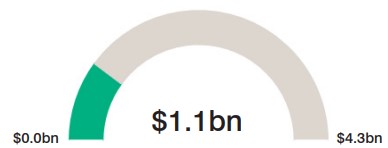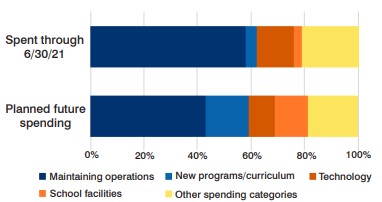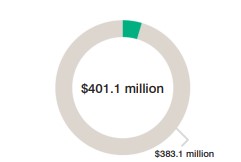Arizona school districts’ and charter schools’, and ADE’s discretionary, COVID-19 federal relief spending—through June 30, 2021
This special report provides summary information and 3 interactive dashboards with Arizona school districts’ and charter schools’ (districts and charters) reported spending through June 30, 2021, and planned spending of allocated/awarded COVID-19 federal relief monies (awards), as required by Laws 2021, Ch. 408, §54.
This special report also provides Arizona Department of Education (ADE)-reported spending through June 30, 2021, and planned future spending of the discretionary COVID-19 federal relief monies that it received, as required by the law. This information is included below the dashboards.
Summary
| Districts and charters reported spending nearly $1.1 billion, or 24.8 percent, of their just over $4.3 billion allocated COVID-19 federal relief monies through June 30, 2021. | Districts and charters reported spending and planning to continue spending the largest portion of COVID-19 federal relief monies, 57.6 percent and 43 percent, respectively, on maintaining operations. | ADE has identified spending priorities for its $401.1 million of discretionary COVID-19 federal relief monies, of which $383.1 million, or 95.5 percent, remained to be spent as of June 30, 2021. |
 |
 |
 |
Districts’ and charters’ COVID-19 federal relief spending and planned spending interactive dashboards
To access information, first choose which of the 3 dashboards you want to use—Total, Districts & Charters, or Districts & Charters per pupil—by selecting the applicable button along the top. Along the left side, you can select different options to filter the data by several categories, such as district or charter, as desired. To enlarge a table or chart, choose the focus mode option at the item’s top-right.
Gauge chart— Provides total spending of awards for the group selected on the Total dashboard, or for the district or charter selected on the other 2 dashboards.
Data table— Provides grant award information in total for the selected group by legislative district on the Total dashboard, or by district or charter on the other 2 dashboards. You can expand the detail shown to the grant level using the plus-sign (+) to the left of the first column of data, which will be either the legislative district, grant name, or district or charter name. See the “Grant allocation amounts, enabling federal acts, and allowable spending time frames” section below the dashboards for additional information about reported grant awards.
Pie charts —Provide spending through June 30, 2021, and planned future spending by category. Hover over a pie piece to see that category’s dollar amount and percentage. See the "Dashboard footnotes and district and charter spending category descriptions" section below the dashboards for additional information.
ADE spent $18 million of its $401.1 million discretionary COVID-19 federal relief monies through June 30, 2021
Between March 2020 and November 2021, ADE received a total of $401.1 million in discretionary COVID-19 federal relief monies, of which $220.2 million was categorized as administrative and discretionary monies and $180.9 million was required set-aside money for State-wide strategic projects and investments that support schools’ recovery needs and increase learning opportunities for students.
ADE reported spending $18 million, or almost 4.5 percent, of its discretionary monies through June 30, 2021. Most of this spending, $11.4 million, or 63 percent, was provided to districts and charters for additional relief funding with an additional $100 million, or 26.1 percent of the $383.1 million total remaining amount, planned to be spent for the same purpose. ADE’s reported spending through June 30, 2021, and planned future spending, by category, and goals and descriptions are provided below. ADE’s website contains additional spending details at https://www.azed.gov/esser-setaside and https://www.azed.gov/esser/sea-esser-application.
|
|
|
| Additional relief funding to public schools —Goal: Baseline levels of relief funding for all public schools. | |
|
Provide additional funds to ensure a baseline level of relief funding for public-school districts, non-profit charter, and career and technical education districts.
|
|
| Student equity and achievement—Goal: Increase proficiency for all students and close achievement gaps. | |
|
Engaging and empowering Arizona students to reach their full potential and providing opportunities for equitable academic outcomes so all students have access to multiple pathways to achieve life-long success.
|
|
| Educator recruitment and retention—Goal: Every student has access to qualified educators and leaders. | |
|
Inadequate retention and recruitment of teachers and other professionals providing specialized student support, such as school counselors, has led to a staffing shortage in schools. Highly effective teachers in the classroom are the biggest predictor of student success. Arizona must foster a robust, statewide teaching profession where educators can grow and thrive professionally and personally.
|
|
| Safe and healthy schools— Goal: All students will learn and grow in a safe and healthy environment. | |
|
Integral to every child’s education is their social-emotional well-being, of which mental and physical health and safety have a primary role. Schools need resources and information to sustain safe, healthy, supportive, and inclusive environments for students, families, and educators.
|
|
| Serving the Arizona school communities and families through the pandemic— Goal: Help schools and families address disruptions resulting from the emergency of the pandemic . | |
|
Schools also need support to help prepare for safe school openings, as well as future disruptions to health and access to learning.
|
|
| Bridging the digital divide and providing access to digital resources— Goal: Bridge the digital divide and provide access to broadband. | |
|
Provide relief to meet immediate needs and address ongoing needs and solutions that strengthen connectivity across Arizona and its school communities.
|
|
| Post-secondary access and attainment— Goal: All students are prepared to access, and succeed in, post-secondary learning opportunities. | |
|
Post-secondary access and success is vital to ensuring all students reach their full potential.
|
|
| Administration | |
|
Supporting ADE’s grant oversight operations.
|
|
| Other and indirect costs— Goal: Other & Indirect Costs includes funds allocated for indirect cost recovery and state projects that are in process for finalization and/or public announcement. | |
|
Indirect costs represent the expenses of doing business that are not readily identified with a particular grant, contract, project function or activity, but are necessary for the general operation of the organization and the conduct of activities it performs. ADE recovers indirect costs on funds allocated for ESSER State Projects per ADE's U.S. Department of Education (USED) approved Indirect Cost rate agreement.
|
|
| ESSER III required set-aside monies | |
|
Set-aside funds will be allocated in FY 2022 toward statewide strategic projects and investments that will support schools' recovery needs and increase learning opportunities for students through 2024, primarily per a Request for Grant Proposal Application (RFGA) process based on the recommendations of the Equitable & Effective Schools Taskforce and ADE's ESSER III State Plan, approved by USED on 10/07/2021.
|
|
(1) Charter closed after fiscal year (FY) 2020. We reported all data that was available and used FY 2020 number of students to calculate per pupil spending in the 3rd dashboard.
(2) Charter closed after fiscal year 2021. We reported all data that was available.
(3) District or charter did not submit completed COVID reporting forms to report their spending and planned spending. We reported only known allocated award amounts provided by applicable grantors.
(4) District or charter reported total spending by category that did not agree to its reported total award spending from all COVID-19 federal relief grants. We adjusted category spending in maintaining operations or other allowable spending categories as applicable to align category spending to total award spending.
(5) Seven districts transport all their students to other districts. We have reported 1 student attending to calculate per pupil spending.
(6) District or charter reported grant award spending that exceeded the allocated award amount for ESSER or CRF/ESG grants. We moved excess spending to another ESSER grant to avoid reporting negative remaining grant amounts.
Maintaining operations and continuity of educational services — Including payments to continue employing existing staff and payments for planned operating costs.
New programs/curriculum to address learning loss and unique student needs — Including academic progress assessments, instructional delivery modifications, summer enrichment, after-school programs, etc.
Mental and medical health services and support for students and/or staff — Including counseling, COVID-19 testing, and vaccinations.
Personal protective equipment (PPE) and cleaning and sanitizing — I ncluding face masks; plexiglass barriers and shields; cleaning and sanitizing supplies and equipment; contracted cleaning services; and additional cleaning personnel costs.
Technology-related spending — I ncluding hardware, software, and connectivity equipment and fees.
School facility repairs, improvements, and additions — Including allowable inspection, testing, maintenance, and upgrade projects to existing facilities or renting new space.
Food service programs — Including staff, equipment, supplies, and transportation costs to deliver meals to students.
Miscellaneous— Including staff training and other allowable grant purposes.
ESSER grants —Districts and charters reported more than $3.7 billion allocated in Elementary and Secondary School Emergency Relief (ESSER) grants from ADE through the Coronavirus Aid, Relief, and Economic Security (CARES) Act, Coronavirus Response and Relief Supplemental Appropriations (CRRSA) Act, and American Rescue Plan (ARP) Act. As required by the federal acts, ADE allocated 90 percent of ESSER monies proportionately to districts and charters based on federal Title I, Part A, eligibility. Title I, Part A, of the Elementary and Secondary Education Act, as amended by the Every Student Succeeds Act, provides financial assistance to districts and charters with high numbers or high percentages of children from low-income families to help ensure that all children meet challenging State academic standards. ADE reported using its discretion over the 10 percent remaining ESSER monies to allocate amounts to non-Title I districts, including career and technical education districts, and nonprofit, non-Title I charters.
CRF/ESG grants —The Arizona Governor’s Office determined districts’ and charters’ Coronavirus Relief Fund Enrollment Stability Grant (CRF/ESG) allocations based on enrollment losses between FY 2020 and the FY 2021 40th-day, and awarded districts and charters nearly $370 million in November 2020. CRF/ESG monies were required to be used no later than December 2020. However, some districts and charters reported spending less than their CRF/ESG grant award resulting in reported remaining amounts to spend.
Other grants —Various other federal, State, and local governments have provided more than $225 million to districts and charters from monies specified in the federal acts related to the COVID-19 pandemic, with allowed spending from March 2020 through various end dates.
|
Grant |
Federal enabling act |
Allocation amount |
Allowable spending end date |
|
|
ESSER I |
CARES Act |
$ 262,897,967 |
9/30/22 |
|
|
ESSER II |
CRRSA Act |
1,081,207,269 |
9/30/23 |
|
|
ESSER III |
ARP Act |
2,363,957,958 |
9/30/24 |
|
|
ESSER grants total |
|
3,708,063,221 |
|
|
|
CRF/ESG |
CARES Act |
367,265,895 |
12/30/20 |
|
|
Other grants |
Various acts |
225,183,708 |
Various dates |
|
|
Total grants |
|
$4,300,512,824 |
|
|
As shown below, districts and charters must apply for their grant allocations to be eligible to receive reimbursement for allowable grant spending.
|
Grant payment cycle |
|||
|
|
Grant award spent |
|
|
|
|
|
|
|
|
|
|
|
If awarding agency approves reported spending, grant recipient is reimbursed. |
Grantor agencies are responsible for communicating federal allowable spending guidance, approving grant applications, and monitoring districts’ and charters’ spending for allowable use. For example, ADE provides guidance and monitoring for ESSER grants, which in total represented the largest portion of the COVID-19 federal relief monies allocated to districts and charters through November 2021. Grantor agencies are responsible for federally required reporting and monitoring of the allowable uses of grant monies through monitoring processes, including reviewing related findings in grant recipients’ audit reports. Under federal and State law, most districts and all charters are required to have independent auditors perform annual financial and compliance audits. Arizona Revised Statutes §15-914 describes districts’ and charters’ audit requirements. Further, districts and charters that expend more than $750,000 in federal monies in a fiscal year are subject to federal single audit requirements.
We worked with ADE, other grantors, districts, and charters to develop the spending categories for district and charter total COVID-19 federal relief grant spending and planned spending across all related grants as shown in the 3 dashboards. Although ESSER grants, in total, allow spending that could be classified in each of these categories, not all COVID-19 federal relief grants allow spending in each of the spending categories. For example, allowable uses of monies reported as Other grants, including Federal Emergency Management Agency grants and Small Business Administration Paycheck Protection Program monies, were more restricted and likely fit in only 1 of the spending categories.
We compiled 236 districts’ and 436 charters’ reported spending and planned spending by category from their FYs 2020 and 2021 COVID-19 reporting forms we developed and required districts and charters to complete and submit to ADE. The 236 districts included transporting districts, career and technical education districts, and accommodation districts and the 436 charters operated in either or both FYs 2020 and 2021. Data used in the dashboards is included in this data file .
We reported information from the following sources:
District/Charter name —Our analysis of ADE-provided district and charter names used in its school report card website. We added a location to the end of some charter names to distinctly identify charters with otherwise identical names operated under separate charter contracts.
County —Our analysis of ADE-provided county data. For district boundaries encompassing more than 1 county, the county in which the district office resides is presented.
Number of schools —Our analysis of ADE-provided school report card information, including online schools and preschools.
Students attending —Our analysis of ADE-provided, district- and charter-reported FY 2021 student attending counts, rounded to the nearest whole number. Districts that transport all their students to other districts were shown with 1 student attending to calculate per pupil spending in the 3rd dashboard. For charters that operated in FY 2020 but not in FY 2021, we reported FY 2020 student attending counts.
Legislative district(s) —Our analysis of district and charter locations within legislative district boundaries based on ADE-provided school addresses.
We performed limited validation on the districts’ and charters’ unaudited, reported COVID-19 federal relief spending information. We compared district and charter reported spending by grant and by category, in total, and we compared reported grant allocation/awards to data obtained from grantor agencies described below:
ESSER I, II, and III —ADE-reported ESSER allocations and awards.
GEER —ADE-reported Acceleration Academies Grant provided from Governor’s Emergency Education Relief (GEER) grants and Arizona Governor’s Office-reported other GEER grants.
CRF/ESG —Arizona Governor’s Office-reported CRF/ESG awards.
Other COVID-19 grants
DEMA —Arizona Department of Emergency and Military Affairs (DEMA)-reported Federal Emergency Management Agency Public Assistance Program Grant and Express Pay payments.
National School Lunch Program —ADE’s Health and Nutrition Services Division reported district and charter food service program cost reimbursements from COVID-19 federal relief monies for March through September 2020.
Paycheck Protection Program (PPP) —Small Business Administration PPP loan forgiveness data as of December 1, 2021.
We compiled ADE’s use and planned use of discretionary monies from the federal acts related to the COVID-19 pandemic and reported them by category with the goals and descriptions ADE provided.